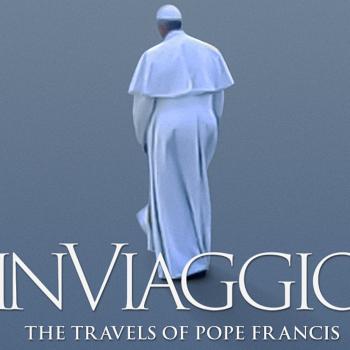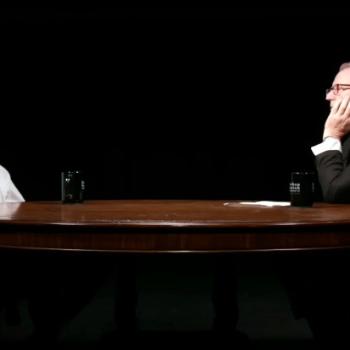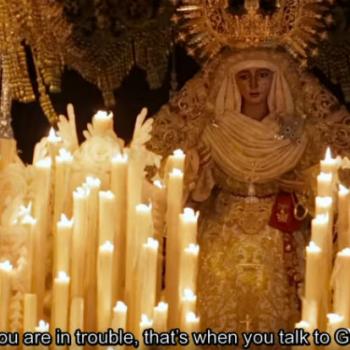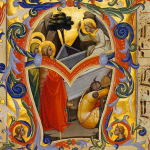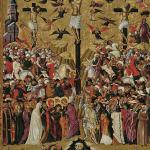The 2013 story from the archives continues:
In the Gospel of Matthew, Jesus asks his disciples who they think he is. Galilean fisherman Simon son of Jonah pipes up, saying, “You are the Messiah, the Son of the Living God.”
Declaring that the only way Simon could know this is if it came straight from God, Jesus continues with, “And so I say to you, you are Peter” – from the Latin “Petrus,” meaning “rock,” translated from the Syriac or Aramaic “Cephas” and the Greek “Kepha” – “and upon this rock I will build my church, and the gates of the netherworld shall not prevail against it.
“I will give to you the keys of the kingdom of heaven; and whatever you bind on earth shall be bound in heaven; and whatever you loose on earth will be loosed in heaven.”
Since Jesus is not recorded as making a similar pronouncement about any of the other apostles, the Catholic Church sees Peter as first among them, with special privileges and responsibilities.
In addition, according to writings by such early Church Fathers of the First and Second Centuries as Ignatius of Antioch and Irenaeus, Peter and Paul, a convert and former persecutor of Christians, founded the Church in Rome. Peter then served as its bishop and was martyred there with Paul.
So, based on these, the Bishop of Rome is the head of the Roman Catholic Church and also carries the title of Supreme Pontiff or Pope. The Church traces a line of popes from Peter over 2,000 years to the current Francis (who seems to prefer the title of Bishop of Rome).
And since Jesus promised Peter that the “gates of the netherworld” would not prevail over the Church, and that it would remain under His protection and the guidance of the Holy Spirit for all time, the Church holds that, under certain circumstances, the Holy Spirit guides and protects the pope, allowing him to speak religious truth without error.
This is called speaking “ex cathedra,” or from the Chair of Peter (it’s a theological term and does not refer to the pope holding audience from a particular piece of fancy furniture).
The reasoning is that, without a belief that there are times when the Holy Spirit does this, then the promise of eternal protection and guidance wouldn’t be worth much in a practical sense.
Although defended in the Church since the Middle Ages, the doctrine of papal infallibility was not defined until the First Vatican Council of 1869-’70. It applies only when the pope is acting as teacher and shepherd, from his position of apostolic authority, in defining doctrines concerning faith or morals that apply to the whole Church.
In the modern era, infallibility has been invoked only once. In 1950, Pope Pius XII declared that the Virgin Mary, on her death, had been assumed body and soul directly into Heaven. With that, the Assumption of Mary became official Church doctrine.
Papal teaching documents, such as encyclicals, may not have the stamp of infallibility nor occupy the most authoritative spot in the general hierarchy of Church documents, but they carry the significant weight of the Supreme Pontiff’s teaching authority.
While not adding to the deposit of faith, these documents – as outlined in section 25 of“Lumen Gentium” (Latin for “Light of the Nations”), the “Dogmatic Constitution on the Church,” issued by the Vatican II council in 1964 – are regarded as definitive interpretations of existing Church doctrine.
But, sometimes, popes say things that are just their personal opinions, such as Francis’recent comment that priests and religious sisters shouldn’t rush to get the latest smartphone or model of car but instead pick something more humble and devote additional resources to helping the poor.
While a remark like this has considerable moral authority because it comes from a pope – and may prick the consciences of clergy and lay people – it doesn’t rise to the level of an article of faith that all Catholics must believe or obey (to the undoubted relief of electronics and auto manufacturers worldwide).
So, then, what is the value of reading “Lumen Fidei,” and would any ordinary person not deeply versed in theology be able to understand it?
As to the first question, it does reflect an infrequent opportunity to see a sort of papal mind-meld, in which the work of scholarly, bookish Benedict is finished off by the expansive, spontaneous Francis. And, it’s only 80 pages, so it can be polished off over the course of an evening.
Second, the English translation is written in clear, expressive language in talking about the meaning of faith in theory and in practice – from Abraham through the Christian era – and its relationship to human reason, with many references to the particular challenges of the 21st Century.
It also touches on the hot-button issue of how to define marriage, reiterating the doctrine and explaining why – SCOTUS decisions notwithstanding – the Church will not vary from its characterization of Holy Matrimony as the lifelong union of one man and one woman.
In addition, “Lumen Fidei” refers to World Youth Day, started by soon-to-be-saint Pope John Paul II, which is celebrated every year, with large global gatherings held every two or three years.
“We have all seen,” it says, “during World Youth Days, the joy that young people show in their faith and their desire for an ever more solid and generous life of faith. Young people want to live life to the fullest.”
Image: Kate O’Hare
Don’t miss a thing: head over to my other home at CatholicVote and like my Facebook page.









